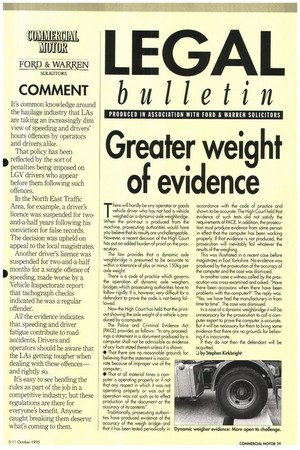Greater weight of evidence
Page 41

If you've noticed an error in this article please click here to report it so we can fix it.
There will hardly be any operator or goods vehicle driver who has not had a vehicle weighed on a dynamic-axle weighbridge. When the print-out is produced from the machine, prosecuting authorities would have you believe that its results are unchallengeable. However, a recent decision of the Hich Court has put an added burden of proof on he prosecution.
The law provides that a dynamic axle weighbridge is presumed to be accurate to within a tolerance of plus or minus 1 50kg per axle weight. There is a code of practice which governs the operation of dynamic axle weighers bridges which prosecuting authorities have to follow rigidly. It is, however, very difficult for a defendant to prove the code is not being followed.
Now the High Court has held that the printout showing the axle weight of a vehicle is produced by a computer. The Police and Criminal Evidence Act (PACE) provides as follows: "In any proceedings a statement in a document produced by a computer shall not be admissible as evidence of any facts stated therein unless it is shown: • That there are no reasonable grounds for believing that the statement is inaccurate because of improper use of the computer; • That at all material times a computer is operating properly or if not that any respect in which it was not operating properly or was out of operation was not such as to effect production of the document or the accuracy of its contents". Traditionally, prosecuting authorities have produced evidence of the accuracy of the weigh bridge and that it has been tested periodically in accordance with the code of practice and shown to be accurate. The High Court held that evidence of such tests did not satisfy the requirements of PACE. In addition, the prosecution must produce evidence from some person in effect that the computer has been working properly. If that evidence is not produced, the prosecution will inevitably fail whatever the results of the weighing. This was illustrated in a recent case before magistrates in East Yorkshire. No evidence was produced by the prosecution of the accuracy of the computer and the case was dismissed. In another case a witness called by the prosecution was cross-examined and asked: "Have there been occasions when there have been problems with the computer?" The reply was: "Yes, we have had the manufacturers in from time-to-time". The case was dismissed.
In a case of a dynamic weighbridge it will be unnecessary for the prosecution to call a computer expert to prove the computer is accurate. But it will be necessary for them to bring some evidence that there are no grounds for -believing it is inaccurate.
If they do not then the defendant will be acquitted. CI by Stephen Kirkbright




































































































































